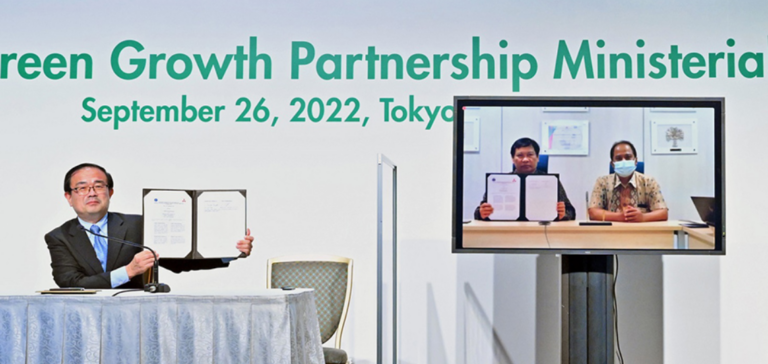Mitsubishi Heavy Industries (MHI) and Institut Teknologi Bandung (ITB) are launching research into ammonia power generation with gas turbines in Indonesia. With this new agreement, MHI and ITB are continuing a collaboration to develop technologies that will accelerate the transition in Indonesia.
The signing of a new agreement
In 2020, MHI and ITB entered into a memorandum of understanding for joint research on energy solutions. In February 2022, the two partners agreed to a five-year extension of the agreement.
Thus, under the same MOU, research will be conducted using ITB facilities. These will aim to promote technological development between Japan and Indonesia.
A signing ceremony was held in Tokyo at the 2nd Ministerial Meeting of the Partnership for Green Growth in Asia. Gede Wenten, Vice Rector of ITB, shared his thoughts on this new cooperative venture:
“The energy transition plays an important role in reducing global greenhouse gas emissions and, in the long run, will have an impact on reducing global warming or climate change.”
Finally, in addition to the ammonia research, the partners will work on the commercial application of ammonia power generation in Indonesia.
Ammonia, a major player in the transition?
Although ammonia is not yet widely used in the energy transition, it could become a major player. Easy to produce, transport and especially to store, it is also less expensive than hydrogen. The only concern is that scientists do not yet have a detailed understanding of its combustion.
Japan in particular is trying to speed things up even though several obstacles remain. The development of new gas-fired power plants, specially adapted to ammonia, is necessary to be able to control its polluting emissions.
The production of ammonia can cause pollution. Gas manufacturers must develop carbon capture and recovery systems. Therefore, these techniques would make it possible to produce “blue” ammonia, in comparison to “grey” ammonia, obtained from fossil and polluting resources.
Gede Wenten would like to continue the research in this direction:
“In the long term, we can expect NH3 production to include more green NH3 that uses renewable energy. I hope this joint R&D will have a positive impact on sustainable energy transition efforts.”
The research conducted by MHI and ITB is therefore to efficiently produce green ammonia from suitable gas turbines.
Indonesia accelerates its transition
This new MOU comes at a time when Indonesia is stepping up its efforts to accelerate its energy transition. The country is committed to increasing the share of renewable energy to 23% by 2025.
Junichiro Masada, director of MHI’s Energy Transition Division, supports this:
“I am confident that truly innovative research in the field of clean energy technologies will result from this collaboration. Working closely with ITB will certainly give rise to new ideas and advance the energy transition in Indonesia.”
The climate crisis is expected to cause the demand for ammonia to explode in the coming years.






















